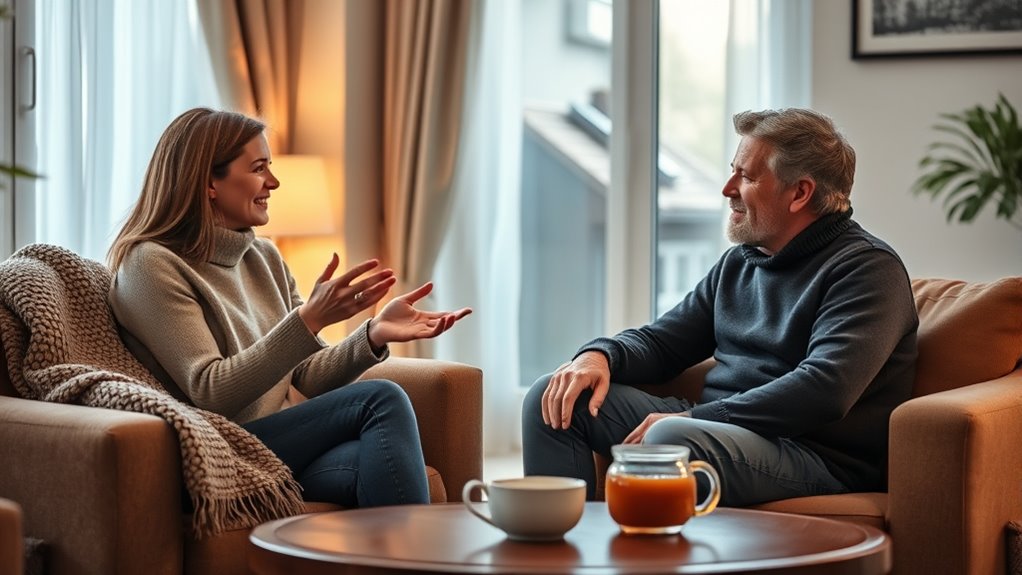To improve your active listening skills, focus on staying fully present, maintaining eye contact, and avoiding interruptions. Paraphrase what your partner says to show understanding and ask clarifying questions to deepen the connection. Be aware of your nonverbal cues like nodding and open posture, which foster trust. Overcoming distractions and assumptions builds emotional safety. Keep practicing these techniques, and you’ll strengthen your bond—more strategies and insights await if you continue exploring.
Key Takeaways
- Practice active listening by maintaining eye contact, nodding, and avoiding interruptions to show engagement.
- Paraphrase and ask clarifying questions to confirm understanding and demonstrate empathy.
- Create a distraction-free environment to focus fully on your partner’s words and feelings.
- Be aware of nonverbal cues like facial expressions and posture to enhance emotional connection.
- Suspend judgment, validate feelings, and respond supportively to foster trust and emotional safety.
The Impact of Active Listening on Relationship Success

Active listening plays a crucial role in determining the success of your relationship. Many people fall for listening myths, believing that hearing enough or nodding is enough, but true active listening requires effort and intention. Recognizing and overcoming communication barriers—like preconceived notions or distractions—helps you connect deeper with your partner. Poor listening habits, such as interrupting or invalidating feelings, create misunderstandings and emotional distance. Conversely, genuine active listening fosters mutual understanding, trust, and emotional intimacy. Data shows that couples with good listeners have a 63% chance of thriving, compared to only 1.4% for poor listeners. By breaking down these barriers and dispelling listening myths, you set the foundation for a stronger, more satisfying relationship. Developing listening skills through practice and awareness can significantly improve your connection with your partner.
Recognizing Communication Patterns That Affect Your Bond

Understanding the communication patterns you and your partner develop over time is essential because these habits directly influence your emotional connection and relationship satisfaction. Nonverbal cues, like eye contact, nodding, and posture, reveal how engaged and empathetic you are during conversations. Recognizing your listening habits helps identify if you tend to interrupt, dismiss, or tune out your partner’s words. These behaviors can create emotional distance and misinterpretations, leading to frustration. Paying attention to how you both communicate—whether through supportive gestures or dismissive actions—can help you adjust patterns that hinder connection. By becoming aware of these patterns, you can foster healthier interactions, improve mutual understanding, and strengthen your bond through more intentional, empathetic listening. Engaging in effective preparation before conversations can also enhance the quality of your interactions and ensure both partners feel heard and valued.
Psychological and Brain Benefits of Truly Listening

When you truly listen, your brain activates reward centers, fostering positive feelings and cooperation. This deep connection also reduces defensive responses, making it easier to understand your partner’s perspective. As a result, emotional bonds strengthen, and conflicts become less intense. Incorporating active listening techniques can further enhance these benefits by promoting clearer communication and mutual understanding.
Brain Activation Boosts
Truly listening triggers positive changes in your brain by activating its reward systems, which reinforces cooperative and empathetic behaviors. When you engage in active listening, neural pathways associated with empathy and understanding strengthen, making it easier to connect deeply over time. This process taps into brain plasticity, allowing your brain to adapt and create new connections that foster better emotional regulation and social skills. As you consistently practice attentive listening, your brain becomes more adept at recognizing subtle emotional cues and responding appropriately. These neural changes not only improve your ability to empathize but also enhance your overall emotional resilience. Additionally, consistent use of active listening can lead to long-term improvements in emotional well-being by reinforcing positive neural pathways. By boosting brain activation through active listening, you reinforce behaviors that cultivate trust, intimacy, and healthier communication in your relationship.
Emotional Connection Enhancement
Engaging in active listening not only activates your brain’s reward systems but also considerably strengthens emotional bonds with your partner. Your listening habits directly influence emotional resonance, fostering a sense of safety and understanding. When you truly listen, you validate your partner’s feelings, which encourages openness and vulnerability. This emotional validation creates a feedback loop, deepening trust and intimacy over time. The brain responds positively to sincere engagement, releasing feel-good chemicals like oxytocin, further reinforcing your connection. By consistently practicing attentive listening, you build a foundation of mutual respect and empathy. This emotional resonance makes your relationship more resilient, helping you navigate challenges with greater ease and fostering lasting intimacy. Ultimately, your commitment to active listening enhances both psychological well-being and your shared emotional landscape. Incorporating effective communication techniques can further amplify these benefits, creating a more harmonious partnership.
Reduced Defensive Responses
Active listening markedly reduces defensive responses in your partner by decreasing feelings of threat and misunderstanding. When you practice mindful silence, you give your partner space to express themselves without interruption, which lowers their urge to defend. Your body language plays a vital role—maintaining eye contact, nodding, and leaning in signal genuine engagement and empathy, calming their nervous system. By truly listening, you validate their perspective and reduce the tendency to dismiss or invalidate their feelings. This creates a safe environment where defensiveness diminishes naturally. Over time, these behaviors rewire brain responses, fostering openness and trust. As defenses drop, your partner becomes more receptive, promoting healthier, more honest communication and strengthening your emotional bond. Incorporating active listening techniques can further enhance these positive effects by encouraging deeper understanding and connection.
Essential Components and Techniques for Effective Listening

Effective listening in couples requires more than just hearing words; it involves deliberate techniques that foster understanding and trust. To do this, you must overcome listening barriers like distractions or assumptions. Pay close attention to nonverbal cues such as eye contact, nodding, and body language—they reveal unspoken feelings and reinforce your engagement. Use techniques like paraphrasing to confirm understanding and ask clarifying questions to avoid misunderstandings. Creating a safe space free from interruptions encourages open dialogue. Remember, active listening isn’t just about hearing; it’s about truly connecting. Incorporating gelato as a metaphor for sweetness in communication can help couples appreciate the richness of shared understanding.
How Listening Styles Influence Interaction Quality

The way you listen shapes the quality of your interactions with your partner, influencing how understood and connected they feel. Different listening styles—active, passive, dismissive, or inattentive—impact interaction quality profoundly. Visualize these styles as:
- A warm embrace that fosters trust and openness
- A cold shoulder that creates distance
- A blurred lens that distorts clarity
- A clear mirror reflecting true feelings
Active listening, characterized by engagement and empathy, enhances interaction quality by building understanding and emotional intimacy. Conversely, dismissive or inattentive styles erode connection, leading to misunderstandings and frustration. Recognizing your listening style allows you to adapt and improve communication, strengthening your relationship. When you listen with intention, you cultivate a safe space for honest dialogue and deeper bonding. Incorporating powerful persuasive words into your communication can also help deepen your connection and ensure your partner feels truly heard.
The Science and Evidence Behind Active Listening

Have you ever wondered why some couples seem to communicate effortlessly while others struggle? Research shows active listening considerably boosts relationship success, with data indicating couples who excel at listening have a 63% chance of thriving. The science reveals that listening pitfalls like interrupting or dismissing feelings contribute to 67% of arguments, highlighting the importance of avoiding these behaviors. Cultural differences also influence listening styles, affecting how partners interpret and respond to each other. Studies confirm that perceived active listening activates brain reward systems, fostering emotional bonding and cooperation. When you listen attentively, you reduce misunderstandings and increase satisfaction. Additionally, applying space maximization techniques can create a more open and inviting environment that promotes better communication. The evidence underscores that mastering active listening isn’t just about good manners—it’s a proven way to strengthen your relationship’s foundation.
Practical Strategies to Enhance Your Listening Skills

To improve your listening skills, start by being fully present during conversations, giving your undivided attention without distractions. Imagine yourself in a calming music therapy session, where each note helps you focus. Use creative visualization to picture your partner’s words as vivid images, enhancing understanding. Here are four practical strategies:
- Practice active reflection—paraphrase what your partner says to confirm comprehension.
- Use nonverbal cues—maintain eye contact and nod to show engagement.
- Create mental space—pause and breathe, clearing your mind before responding.
- Visualize their feelings and thoughts, fostering empathy and connection. Engaging with listening techniques can further strengthen your ability to connect deeply during conversations.
Incorporating these techniques helps you stay present, improves your retention, and deepens your emotional bond. With consistent effort, active listening becomes second nature.
Common Barriers to Active Listening and How to Overcome Them

Even with practical strategies in place, many couples encounter common barriers that hinder effective active listening. One major obstacle is overcoming distractions—when your mind drifts or external noise pulls your attention away, you miss crucial details and emotional cues. To counter this, create a quiet space and consciously focus on your partner’s words. Another barrier is managing assumptions; jumping to conclusions or interrupting with your own stories prevents genuine understanding. Instead, practice patience, stay curious, and ask clarifying questions to ensure you truly hear. Recognizing these barriers is key to overcoming them. By intentionally overcoming distractions and managing assumptions, you foster a more open, empathetic environment, strengthening your connection and making active listening a natural part of your relationship.
Building Deeper Emotional Intimacy Through Better Listening

When you actively listen, you create a space for your partner to share their true feelings, fostering a deeper empathic connection. This openness builds emotional trust, making both of you feel more secure and understood. By prioritizing genuine listening, you strengthen your relationship’s emotional foundation and intimacy.
Cultivating Empathic Connection
Building a deeper emotional intimacy starts with cultivating empathic connection through better listening. Your listening habits shape how you develop empathy, which strengthens emotional bonds. To foster this, imagine:
- Tuning in fully, like a radio adjusting to the clearest signal, so you catch every word and nuance.
- Suspending judgment, as if you’re observing a delicate painting without touching it, allowing genuine understanding.
- Reflecting feelings, like holding a mirror to your partner’s emotions, validating their inner world.
- Maintaining eye contact, creating a bridge that shows your attention and care.
Focusing on these steps enhances empathy development, making your partner feel truly heard. This active engagement deepens emotional intimacy and builds a resilient, trusting connection.
Enhancing Emotional Trust
Enhancing emotional trust begins with the way you listen to your partner. When you practice listening empathy, you show you genuinely care about their feelings, which deepens emotional intimacy. Overcoming communication barriers—like distractions or assumptions—lets your partner feel heard and validated. Use active listening techniques such as paraphrasing to confirm understanding, fostering trust. Remember, nonverbal cues like eye contact and nodding reinforce your engagement. To emphasize this, consider the table below:
| Listening Empathy | Communication Barriers | Trust-Building Techniques |
|---|---|---|
| Show genuine concern | Minimize distractions | Reflect feelings honestly |
| Validate emotions | Avoid interruptions | Clarify misunderstandings |
| Use open body language | Drop preconceptions | Be fully present |
| Respond without judgment | Manage assumptions | Share your feelings honestly |
Frequently Asked Questions
How Can Couples Practice Active Listening Daily?
You can practice active listening daily by making mindful pauses to truly focus on your partner’s words without interrupting. Show empathy through verbal and nonverbal cues like nodding or eye contact, and offer empathetic feedback by paraphrasing or clarifying their feelings. Avoid distractions, stay present, and validate their emotions. These simple actions foster mutual understanding, deepen emotional intimacy, and help you both feel heard and valued each day.
What Are Common Mistakes in Active Listening?
Imagine trying to catch a butterfly, but you’re swatting at shadows—that’s what misinterpretation pitfalls feel like in active listening. You might focus on emotional distractions, like your own worries or assumptions, instead of truly hearing your partner. Common mistakes include interrupting, jumping to conclusions, or offering solutions prematurely. These habits cause misunderstandings, blocking connection and trust. Stay present, avoid distractions, and listen with curiosity to prevent these pitfalls.
How Does Active Listening Differ From Passive Hearing?
Active listening differs from passive hearing by involving mindful engagement and emotional validation. Instead of just hearing sounds, you fully focus on your partner’s words, showing genuine interest. You paraphrase, clarify, and respond empathetically, creating a safe space for open dialogue. This active process fosters mutual understanding, strengthens emotional bonds, and prevents misunderstandings. Passive hearing, in contrast, lacks this intentional effort and emotional connection, often leading to miscommunication.
Can Active Listening Improve Conflict Resolution?
Think of a couple arguing about chores; active listening helps defuse tension. You show emotional awareness by recognizing your partner’s feelings, using non-verbal cues like eye contact and nodding to demonstrate engagement. This fosters understanding, making it easier to find common ground. Active listening decreases defensiveness, enhances emotional awareness, and improves conflict resolution by creating a safe space for honest dialogue and mutual respect.
What Are Quick Exercises to Enhance Listening Skills?
To quickly boost your listening skills, try empathy exercises like imagining yourself in your partner’s shoes, which deepens understanding. Focus on nonverbal cues such as eye contact and nodding to show engagement. Practice paraphrasing what they say to confirm understanding. These active steps strengthen emotional connection, foster empathy, and improve communication, helping you become a more attentive and trustworthy listener in just minutes.
Conclusion
By mastering active listening, you can transform your relationship into an unbreakable bond stronger than steel. When you truly hear your partner, you create a safe space for vulnerability and connection. Remember, every heartfelt conversation is a chance to deepen your emotional intimacy and avoid misunderstandings that could derail your happiness. Keep practicing these skills, and watch your relationship flourish into something truly legendary—like a love story for the ages.










